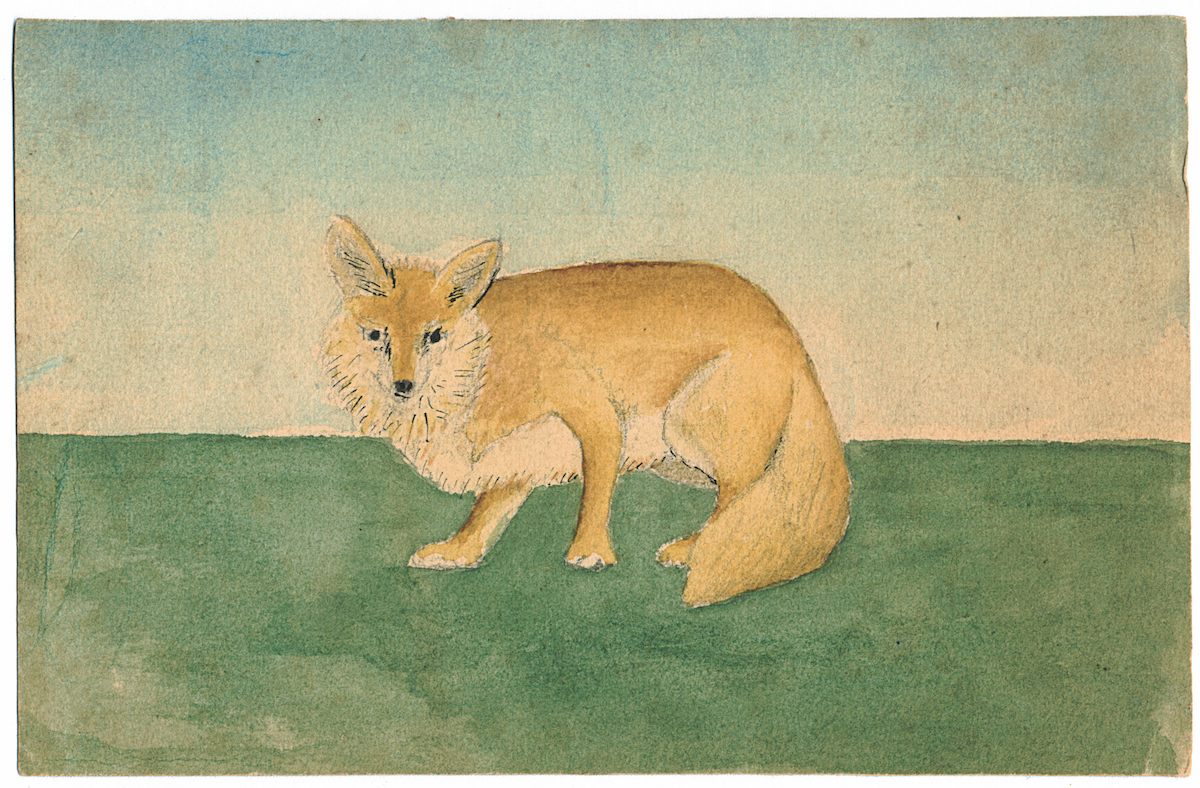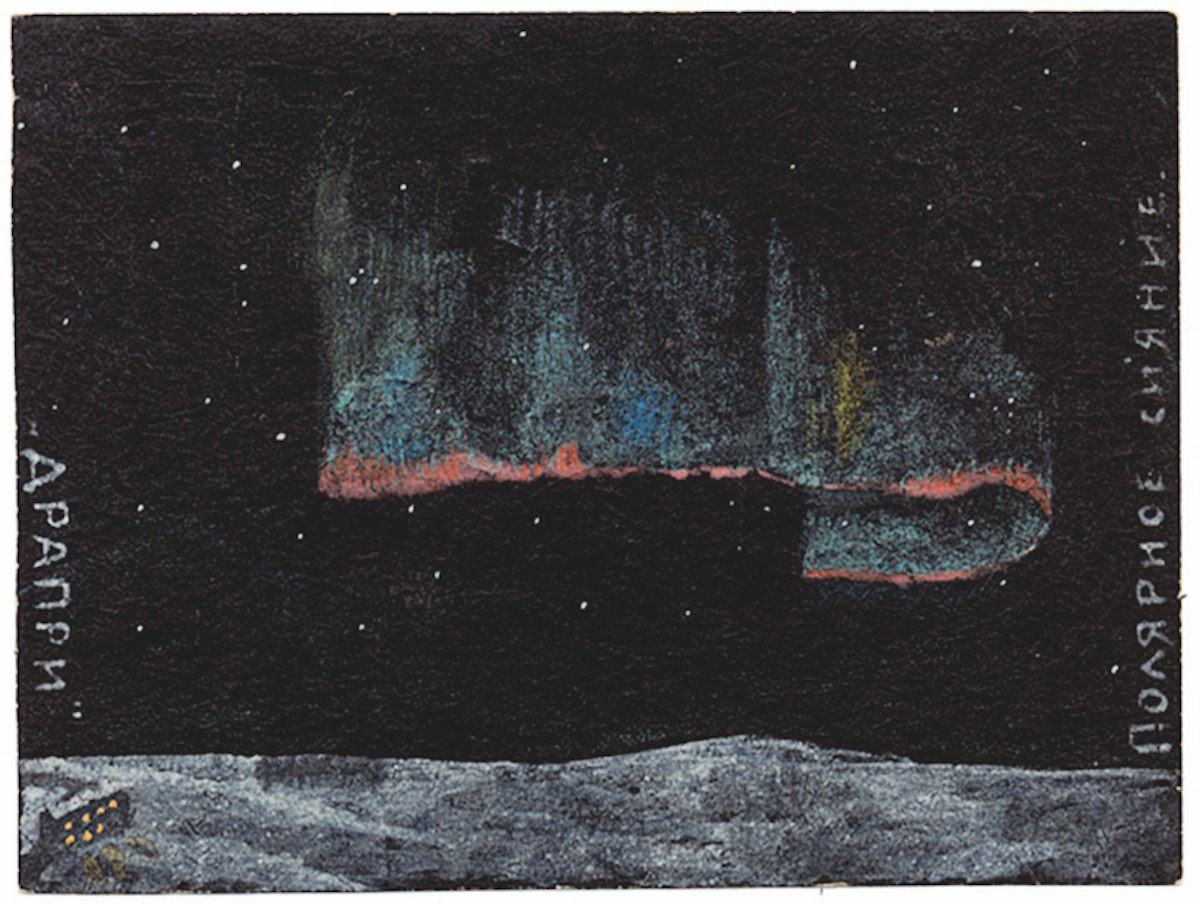The Poignant Gulag Art by Stalin’s Doomed Meteorologist
Imprisoned for “false weather forecasts,” Alexey Wangenheim sent sketches to the family he’d never see again.

An Arctic fox, a hen, wild berries, a reindeer, a single candle glowing in the darkness, glaciers floating at sea, and an aurora borealis. These are some of the subjects of delicate, precise illustrations created by a man imprisoned in a Soviet gulag during the 1930s. The man’s drawings and letters, teeming with melancholy, survive today thanks to his daughter who conserved and published them. His story, as told in Olivier Rolin’s new biography, Stalin’s Meteorologist: One Man’s Untold Story of Love, Life, and Death, is one of tragedy, but also of resilience—the kind that allows a sensitivity and love for the wonders and mysteries of nature to survive the most oppressive, cruel circumstances.
Alexey Feodosievich Wangenheim was born in 1881 in the Ukrainian* town of Krapivno, a name that translates to “the place where nettles grow.” His father, Feodosy Petrovich Wangenheim, was a minor nobleman, a so-called barin. Nurturing his own passion for agronomy—the science of soil and crops—Feodosy encouraged his children to indulge their curiosities and interests in science. Though he studied math and agriculture, Alexey developed an unshakeable fondness for clouds and, in 1929, became the first director of the USSR’s Hydrometeorological Centre.

During his time as head of the Soviet Union’s meteorology department, Alexey worked to establish registries for water, wind, and sunshine, and, in 1930, he created the Weather Bureau in conjunction with the first comprehensive USSR weather forecast broadcasted over radio. These were no easy tasks, as the USSR was a huge territory comprised of vastly different terrains and climates. The primary purpose of Alexey’s work was to better prepare farmers for meteorological events that might affect their crops. The meteorologist, however, could not solve all of the logistical and organizational flaws of Stalin’s model for socialized agriculture, nor interfere with his grander plans. Between 1932 and 1933, a devastating famine in Ukraine killed three million people. Many scholars believe that Stalin caused it intentionally.*
On a snowy January 8, 1934, Alexey’s wife, Varvara, waited for him outside a theatre, but Alexey never arrived. In the midst of great anxiety about treachery and betrayal of the Communist Party, Stalin began arresting and interrogating members of his government. Alexey was taken to Lubyanka, the secret police headquarters, and, after coercion, he eventually signed a confession stating that he knowingly and intentionally disseminated false weather forecasts to sabotage socialist agriculture. To be clear, Alexey was, in fact, innocent of these alleged crimes and was a mere scapegoat for widespread famine and death. He was sentenced to 10 years working at one of the first forced labor camps, a 15th-century monastery turned gulag, situated on the frigid, isolated Solovetsky Islands, an archipelago in the White Sea near the Arctic Circle.

Though Alexey never again saw his wife or three-year-old daughter, Eleonora, he wrote them countless letters detailing life at the camp, his state of mind, and his physical ailments. His letters to his family, along with mosaics of Stalin that he created with scraps of stone, reveal that Alexey’s belief in both his own innocence and the good of the Party remained, on most days, steadfast and unwavering. Most poignant, however, are the illustrations and flower pressings that he sent home to Eleonora. Like his own father, Alexey cared deeply about his child’s education, and his whimsical images functioned as tools for learning about plants, climate, natural phenomena, riddles, arithmetic, and geometry.

There is a quietness, a stillness about all of his illustrations. Alexey’s three iterations of the aurora borealis, with various shades of subdued blues, greens, and grays, show the celestial body swaying and “undulating as if in the wind,” as he put it in a letter from March 22, 1936. Other drawings of sparse rooms and solitary animals, objects, and plants evoke the unimaginable reclusion of the gulag. Indeed, in one letter to his wife and daughter Alexey wrote, “How galling it is to think that others are carrying on, while I have become this utterly useless person who gives lectures to prisoners, and who will be consigned to oblivion on this island hemmed in by ice and darkness.”

And yet, despite the horrors of life as a prisoner, Alexey’s earnest appreciation for Earth’s creatures and phenomena remained intact. He seems to have found joy in the volumes within the gulag’s library, planting trees on the grounds, and giving academic lectures to the other prisoners—some even called him “professor.” Perhaps his misguided, problematic faith in Stalin and his regime contributed to any sense of contentment or peace he felt, but it appears that Alexey’s careful art-making practice afforded him a great deal of comfort and a sense of purpose in the face of incomprehensible chaos. He wrote, along with a drawing of a cat’s head, in a letter from September 20, 1935, “It may seem strange, but this playful little gray creature comforts me.”

Alexey was executed in late 1937, and the truth regarding his sudden disappearance was only fully uncovered 60 years later by the Memorial Research Centre, a historical and civil rights organization that seeks to bring to light the buried crimes of Soviet Russia. He wrote in his last letter to his daughter, “I shall not be able to send you my drawings for a while, but I hope you’ll send me yours.” Alexey also explained that the varakusha “is a bird with a blue back and a browny-orange breast that’s a little like a sort of thrush,” and he inquired about her music lessons.
Eleonora would become a paleontologist with an expertise in vertebrates. Like her father, she was captivated by the phantasmagoria that is the natural world. She eventually published Alexey’s many letters and drawings, which, in turn, inspired Olivier Rolin’s recently released biography. The book includes Alexey’s letters, drawings, and story of heartbreaking entrapment in the cold, unyielding fist of totalitarianism.
*Update: The story originally said that Alexey Wangenheim was born in the Ukrainian Soviet Socialist Republic, which did not exist until 1922. Additionally, it has been updated to reflect the widely held belief that Stalin planned the 1932 famine.
























Follow us on Twitter to get the latest on the world's hidden wonders.
Like us on Facebook to get the latest on the world's hidden wonders.
Follow us on Twitter Like us on Facebook